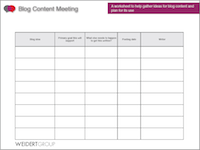Creating quality content is essential for success in organic search, especially with the ongoing algorithm changes that Google keeps making to favor original and useful content based on certain search queries. An important part of optimizing your Inbound Marketing content is to pay attention to the right keywords your ideal customers use when looking for your product or service online.
Like anything in marketing, keyword research can get complicated and highly technical pretty quickly. Technicalities aside, here’s a review of 3 easy keyword research tips that will get you on your way to identifying the right keywords to properly optimize your original content.
1. Evaluate Your Competitors’ Keywords
A great place to start is digging into what some of your top competitors are using for target keywords – especially competitors that seem to be outperforming you in organic search. The easiest way to do this is by visiting their website and taking a look at the source code on various pages of their website, starting with their home page. Steps to do this are as followed:
- Right click on the main content area of the page and select “View Page Source”
- Enter a command find function (command + f) and then enter “keywords”; use the arrow or Next tab to advance through search results on that page
This will quickly direct you to their meta keywords and other meta data, where you can observe the keyword phrases they’ve decided to target. Another quick giveaway is the page title tag that appears in your browser window, which you’ll also be able to see in the source code as outlined above by searching “”.
2. Utilize The Google Keywords Tool
There are a handful of paid keyword tools available online but the good ol’ standby for many marketing professionals, and one we support here at Weidert Group, is Google’s Keyword Tool. This was designed for marketers to identify the right keywords for AdWord campaigns but can quickly inform you the monthly search volume for a specific keyword or keyword phrase, both globally and locally (local meaning U.S. searches), the competitiveness of the keyword and recommended alternatives. The goal is to obviously target relevant keywords for your specific product or service, but making sure your selections are receiving a good level of monthly search volume and that they aren’t overly competitive where it’s going to be next to impossible to rank favorably in the SERPs (search engine results page).
3. Investigate Current SERP Rank
Once you’ve begun to assemble a list of target keywords based on your competitor research and evaluation in the Google Keyword Tool, it’s important to investigate how your website or blog is ranking for those specific keywords in the SERP for that particular search query. This will quickly help you identify which keywords you should target first if you’re already ranking on page five or six of results for example, rather than going for a bunch of keywords where you’re not even ranking in the top 100 results.
If conducting this test in Google be sure you’re not logged in to ensure you’re getting an accurate SERP. Otherwise, you can also try Serp Rank which is a free online tool.
There’s no doubt keyword research can take considerable time and ongoing attention, especially depending on the size of your business and number of products or services you’re hoping to be found for. Hopefully these tips inspire you to get started and help you on your way towards optimizing your website and blog content. For tips on creating valuable content where you can apply your keywords, check out our free Inbound Marketing Content Creation Templates.
